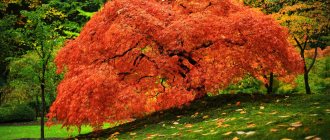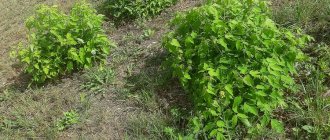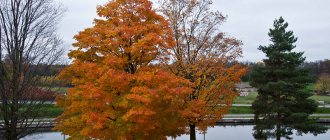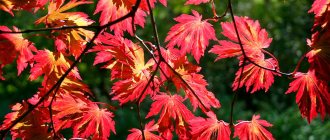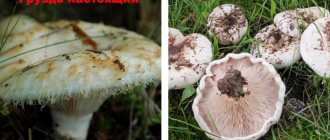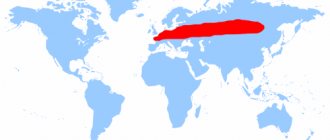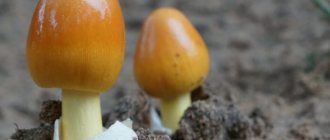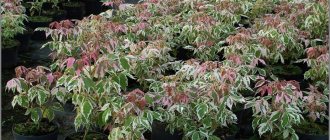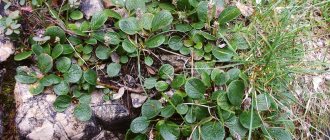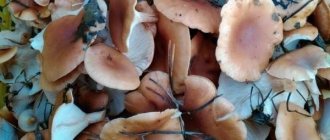Peculiarities
In any botanical reference book, the description of Norway maple begins with the name in Latin. We will not deviate from this tradition – Acer platanoides. There are other names: sycamore, sycamore, common maple. Belongs to the Sapindaceae family and grows in Europe and South-West Asia. Grows alone, sometimes forms dense thickets. In our country it is cultivated for decorative purposes - designing parks, squares, and decorating streets. By the way, the life expectancy of a large fish is decent and amounts to 200-250 years.
Canadian maple
Some more interesting facts:
- Height – up to 30 meters.
- The Canadian maple leaf has coarsely toothed edges. Consists of blades, the edges of which are pointed. The largest leaves reach 18 cm in length and 20 cm in width.
- Painted dark green. In autumn the color becomes orange-yellow and crimson.
- We found out what leaf shape a maple tree has. It has a long petiole that secretes milky juice.
- Flowering period depends on climate. In warm regions, yellow-green flowers appear as early as March, in cold regions in May. The smell is pleasant, neutral. Inflorescences are corymbose. Insects play a key role in pollination.
- In September, fruit appears on the maple tree. Thanks to its unique shape, it cannot be confused with anything else. Imagine a lionfish with seeds in every part. A slight breath of wind - they fly away over long distances. The tree begins to bear fruit at about 17 years of age.
Canadian maple species
- The bark tends to change. In young trees it is smooth and has a gray-brown tint. Every year the trunk becomes covered with more and more longitudinal cracks, becoming almost black. Due to the shallow location of the root system, the maple takes all nutrients from the surface. Therefore, nearby flowers and shrubs grow poorly.
Types of maples
Among the species diversity of maples, several of the most common and popular are distinguished.
Holly
This species is one of the most famous, includes several varieties, and grows throughout the European part of Russia. Another name for maple: sycamore or plane-leaved - based on the characteristic shape of the leaves (pictured).
This species includes many decorative forms, differing in the height of the trunks, the size and density of the crown, and the shade of the leaves. Norway maple is picky about soil composition, prefers moderately moist fertile, slightly acidified soils, and does not tolerate sandstones and rocky soils. These trees reach a height of 20–30 m and have a wide, rounded crown. The bark is light gray, quite smooth in young maples, but becomes cracked with age. The size of the leaves is about 15–18 cm, they are located on long thin stalks, have a five-lobed shape with pronounced notches: the middle lobes protrude far forward, the lateral ones are slightly shorter. There are types of maple with hornbeam or ash-like foliage: small, serrated, elongated leaves arranged transversely on long cuttings.
In autumn, green maple foliage acquires bright yellow, orange, red and burgundy shades, creating a picturesque natural carnival of colors. The five-lobed maple leaf is featured on the Canadian flag.
Trees grow quickly, especially in the first years after planting; their lifespan is up to 200 years. Norway maples are immune to the polluted air of cities, so they are suitable for landscaping streets and creating beautiful landscapes. They are planted along roads, in courtyards, in squares and parks.
Norway maple is distributed throughout European territory, Western Siberia, and the temperate zone of the North American continent.
American
This tree is widespread in the northern and eastern regions of the United States, being the official symbol of some states. Another name for the species is sugar maple. It is from the sap of its wood that the famous maple syrup is made, and lumber is used in construction. American maple is resistant to cold climates, can grow up to 30-40 m, has thick dark bark and a dense crown.
White
This species is often called sycamore or false sycamore. Slender trees up to 30 m in height have a thick tent-shaped crown. The foliage is dark green, the back side is much lighter - whitish, slightly bluish. Sycamore does not tolerate severe frosts, so it is rare in the middle zone; it grows mainly in the Caucasus, the Carpathians, and the southern regions of Europe.
Tatar
It is also called black maple. More often it forms shrub forms no higher than 9 m, the crown is spreading. The bark is dark, almost black, the foliage has finger-like lobes, dark green, and smooth. The Tatarian maple blooms beautifully; in the spring, pale pink, rather large inflorescences, similar to bells, form on the branches. Black maple grows quickly, is easy to trim, and is used as an ornamental plant. It tolerates drought quite well and is widespread in the steppe regions of the European part, the Caucasus, and the Balkans.
Field
A large shrub, dense and tall, up to 15–20 m. The foliage is five-lobed, bright green, the bark is dark, grayish or brown, the inflorescences are small and inconspicuous. Field maple has good adaptive properties, adapts to almost any climatic conditions, is wind-resistant and shade-tolerant, and can easily tolerate short-term drought. Grows in deciduous forests, forest-steppe zones, and in urban environments.
Norway maple care
As mentioned above, planting and caring for Norway maple does not require special knowledge and skills. Even beginners can grow such a tree. It easily tolerates severe frosts down to -40 degrees, and can go for weeks without watering on a dry summer day. Young seedlings need frequent and abundant watering and periodic loosening of the soil. In summer, it is recommended to water once a week, with the calculation of 2 buckets of water per 1 tree. In autumn and spring, the frequency of watering can be reduced to once a month.
Maple green
It is advisable to cover small and immature varieties of maples in November with dry leaves and spruce branches. When the trees grow older, they do without shelter. In spring, sanitary pruning is practiced, during which the diameter of the crown is formed. When you trim the branches, they will begin to grow much more intensively, they will be lush, and the tree itself will be more beautiful.
Transplantation is encouraged only at a young age, up to about 15 years. The older Acer platanoides becomes, the more difficult it is to tolerate transplantation. However, this is much more difficult to do due to the strong growth of the root system and the too thick crown.
Planting and propagation
You can propagate Canadian maple so that the tree grows strong and healthy in different ways: seeds, seedlings, layering. Each method is good in its own way. Choose areas that are well lit by the sun - then the crown will be denser. In places with insufficient sunlight, the leaves become small and the saturation is lost.
The propagation of Norway maple by various methods will be discussed below:
- Seeds. Simply collecting lionfish and planting it in the ground is not enough. Seeds must be stratified. To improve germination, in the fall they are placed in sand or peat and kept in the sand at a temperature of no more than 3 degrees. There is no need to remove the seeds from the wings. Sowed in April. The soil should be moist and fertilized, the optimal depth is 4-5 centimeters. The appearance of sprouts should be expected in two weeks. By the way, they grow quite quickly - up to 60 cm annually. In just 7 years, a two-meter tree will tower over your site. Up to 25 years, this type of maple grows in width and height, then it only increases in width. Development slows down or stops completely after age 50.
Maple on the site
- Saplings. If you have maple seedlings, they can be planted both in the fall (wait for the leaves to fall) and in the spring. It is advisable to do this in March-April, when the buds have not yet bloomed. Particular attention is paid to the integrity of the root system. When purchasing, select seedlings with a large lump. The depth of the hole is at least 50 cm; humus is placed at the bottom. When planting without a clod, carefully straighten the roots to avoid creases, carefully compact them and water them.
- Layerings. Another common method used by both beginners and experienced gardeners. Propagation by cuttings begins with the fact that in the fall you cut woody branches 25 cm long from the tree. Then you bury them in the sand and store them in the basement so that the soil does not freeze. In spring, plant in prepared soil. By the way, you don’t have to wait for autumn, but cut the cuttings in the spring, treat them with growth stimulants, and plant them in the ground, covering them with a plastic bottle.
It is important! When planting maple, the distance between trees should be 2-4 meters. Otherwise, large adult animals will interfere with each other.
NEWS BOOKS ENCYCLOPEDIA SITE MAP LINKS ABOUT THE PROJECTSEM. MAPLE (ACERACEAE)
Deciduous trees or shrubs with opposite simple or compound odd-pinnate leaves without stipules.
Flowers are regular, bisexual or dioecious, quintuple type in terminal or lateral racemes, panicles or corymbs. There are 8 stamens, arranged in two circles; the ovary is superior, bilobed, with two ovules in each socket. The fruit is a dipterate, splitting into two fruitlets after ripening. Seed without endosperm. Embryo with thin folded cotyledons. Mainly entomophilous, honey plants; less often pollinated by wind.
Maples are common in temperate countries in the northern hemisphere. They reproduce by seeds and produce shoots from the stump. They grow quickly. They prefer fresh, deep soils, but are often found in poor soils. Relatively shade-tolerant.
Maple wood is heavy, durable, has a beautiful texture and is used in furniture production, mechanical engineering, musical instruments, plywood, turning products, and various crafts.
Genus Maple (Acer L.)
A genus of trees and shrubs with simple, lobed or pinnate petiolate leaves. The flowers are dioecious, or pseudobisexual (female with underdeveloped stamens), mostly yellow-green, in corymbs or racemes. The flower has a disc (nectary) and two opposite appendages of the ovary, which grow into wings during fruiting.
About 150 species are known. There are 25 species in the USSR. The most common and valuable maples in the forestry of our country are Norway maple, field maple, sycamore maple, Tatarian, light or Colchis, majestic, Georgian, in the Far East - small-leaved, yellow, ginnala, green, in Central Asia - Turkestan maple.
Norway maple, or common sycamore (A. platanoides L.)
Tree up to 30 m high and over a meter in diameter. The crown is dense and wide. The bark on young branches is reddish-gray, smooth, later darkens, on older trees it is gray and finely fissured. The buds are opposite, appressed, the terminal ones are larger, surrounded; two side ones. Leaf scar oblique.
The leaves are dark green, shiny, 5-7-lobed with sharp lobes, 5-12(18) cm long, 8-13(22) cm wide, on petioles up to 15 cm long, glabrous.
The flowers are yellowish-green, male and pseudobisexual (female) on shoots of the last year on the same tree, sometimes dioecious. The calyx and corolla are of a quintuple type, there are 8 stamens, the ovary is flat, glabrous (Fig. 54). Pollinated by insects.
Rice. 54. Norway maple: 1 — branch with flowers; 2 - sheet; 3 - pistillate flower without sepals and petals; 4 - pestle; 5 - staminate flower without cover; 6 - dipteran; 7 — lionfish with a cut out seed nest; 8 - seed; 9 - cross section of the seed; 10 - shoot; 11 - flower buds; 12 - end of shoot with buds; 13 - lateral buds
It blooms simultaneously with the leaves blooming or slightly earlier, in the south at the end of April, then in the first or second decade of May (Table 8).
Table 8. Average and extreme dates for flowering of Norway maple
Observation location
| Flowering date | |||
| average | the earliest | the latest | |
| Novocherkassk | 24/IV(22) | 10/IV | 2/V |
| Kyiv | 29/IV(12) | 20/IV | 10/V |
| Bogoroditskoye-Fenino, Kursk region. | 7/V(13) | 27/IV | 20/V |
| Kaliningrad | 2/V(23) | 11/IV | 16/V |
| Baltiysk | 1/V(20) | 18/IV | 15/V |
| Minsk | 5/V | 14/IV | 15/V |
| Mogilev | 7/V | 15/IV | 18/V |
| Gorki BSSR | 8/V(15) | 24/IV | 16/V |
| Bryansk forestry | 7/V(28) | 18/IV | 19/V |
| Zhizdra | 6/V(15) | 27/IV | 19/V |
| Kaluga | 8/V(34) | 20/IV | 30/V |
| Moscow, Sokolniki | 10/V(15) | 30/IV | 20/V |
| Moore | 8/V(9) | 27/IV | 15/V |
| Kazan | 9/V | 2/V | 15/V |
| Ufa | 14/V(20) | 30/IV | 25/V |
| Sverdlovsk | 18/V(11) | 8/V | 31/V |
| Nerekhta | 12/V(17) | 3/V | 2/VI |
| Leningrad | 15/V(12) | 5/V | 27/V |
| Novgorod | 11/V(15) | 28/IV | 20/V |
The lionfish of the Norway maple are up to 4 cm long each, located almost horizontally, ripen in late August - September and, gradually falling off, partially remain on the branches until spring. Mass loss of lionfish occurs after the first frost. According to observations in the BSSR, Norway maple lionfish begin to fall off in July. In September they fall by more than 28%, in October - about 42%, in November - more than 18%, and the rest in other months.
The seeds are flat. Their germination rate is 85-90%. Under natural conditions, they germinate in early spring in thawed areas among the snow cover. For spring sowing, maple lionfish must be stratified for up to 3 months. Shoots with two tongue-shaped cotyledons and a pair of petiolate, triangular-shaped leaves.
It begins to bear fruit in plantings at the age of 25-30. It is successfully renewed by seeds and produces shoots from the stump. The growth capacity remains up to 60 years. Grows quickly under favorable conditions. Copper shoots in good growth conditions give an increase of up to 2 m per year. From the age of 50, height growth slows down or stops. Lives up to 150-200 years, and sometimes older.
The root system is superficial, the taproot is underdeveloped. Quite shade-tolerant at a young age, later it becomes more light-loving. Rarely forms pure maple stands. It grows in admixture, sometimes significant, in coniferous-deciduous and broad-leaved forests on fresh fertile soils. A typical companion of oak and ash. In the northern regions of its range it grows in spruce and pine forests of the highest quality classes along with linden, elm, elm and other species.
Distributed quite widely in the forests of the European part of the USSR up to 61° N. w. and in the Caucasus in the mountain-forest belt from 600 to 1800 m above sea level and is bred as a forest, field-protective and decorative species up to Arkhangelsk (Fig. 55).
Rice. 55. Maple habitats
The leaves turn golden yellow or orange-red in autumn, which gives the maple a unique charm. Leaves fall in October. Maple is a good spring honey plant. Maple sap contains up to 3% sugar and can be used to produce maple sugar. Maple sap flow begins in March.
Norway maple wood has high physical and mechanical properties, is well polished and is used in furniture, carpentry and turning, mechanical engineering, aircraft manufacturing, is used for the manufacture of musical instruments and is used for various crafts.
Norway maple is little damaged by insects and fungi. Young maples are seriously harmed by hares gnawing the bark around the stem.
Pseudoplatanus maple, sycamore, white maple (A. pseudoplatanus L.)
Close to Norway maple. It reaches a height of 40 m and a diameter of up to 1.5 m. The leaves are dark green, matte on top, bluish-white below, hairy, with five rounded lobes.
The flowers are yellow-green, in long stalked, hanging racemes, appearing after foliation. The lionfish diverge at an acute angle. The seeds are convex and sit in a hairy nest. 1000 fruits weigh 80-110 g. Shoots with two narrow cotyledons and two bare, serrated leaves (Fig. 56).
Rice. 56. Sycamore maple: 1 - branch with leaf and flower cluster; 2 - bisexual flower; 3 - flower with calyx removed; 4 - stamens; 5 — ovary (the left socket is torn); 6 - cross section of the ovary; 7 - dipteran; 8 — lionfish with an open nest; 9 - embryo (on the right is a section along the line a-b); 10 - shoot with leaf buds; 11 - sunrise
Distributed in the southwestern part of the USSR, west of Uman and in the Caucasus, and grown in gardens and parks of the European part of the USSR. It often freezes in Moscow and Leningrad.
It is picky about soils. It grows well in fresh, loose and fairly deep soils. It grows poorly on dry slopes of southern exposure in the mountains. Heat-loving and light-loving. Naturally renews itself by seeds and produces shoots from the stump. At a young age it is severely damaged by rodents.
In open spaces it forms a powerful tent-shaped crown and is very decorative. Used in plantings in the forest-steppe part of Ukraine.
The root system is powerful and deep. Grows quickly.
Sycamore maple wood is used in the same way as Norway maple wood. Of particular interest is the form of sycamore with a wavy wood pattern, known as “bird's eye”.
Sycamore lives to be 100 years or more.
Field maple, tow (A. campestre L.)
The tree is smaller than the one described above. It reaches a height of 15-20 mn with a diameter of up to 60 cm. In the northern part of its range it sometimes grows as a large shrub.
It grows in the forest-steppe and steppe zones of the European part of the USSR, in the Crimea and the Caucasus in deciduous forests. To the north it reaches Zhitomir-Chernigov-Orel-Tula-Ryazan-Tambov (see Fig. 55). In culture it is found in Moscow and Leningrad.
The bark is brownish-gray. Leaves are 3-5-lobed, fluffy. The flowers are yellow-green, in terminal corymbs, staminate with 8 stamens and pistillate with sterile stamens. It blooms somewhat later than the leaves bloom and much later than Norway maple.
The lionfish are spread out almost horizontally, they are shorter than those of Norway maple (Fig. 57). They ripen in September and remain on the tree branches for a long time. The seeds are flat. 1000 fruits weigh 40 g. For spring sowing, lionfish must be stratified for a long time.
Fig 57. Maples: a - field; b - Tatar; c - ash-leaved
Shade-tolerant and more thermophilic than Norway maple. Relatively drought-resistant, tolerates some soil salinity. It is picky about the soil. It grows quickly in youth, but later its growth slows down. Lives up to 100-120 years. It is renewed by seeds, produces shoots from the stump, forms layering, and can produce root shoots from damaged roots. It tolerates shearing well and can be used for making hedges. Honey plant. It is of interest as a suitable species for steppe afforestation. Wood awaits for various crafts.
Tatarian maple, black maple, non-maple (A. tataricum L.)
A large shrub or tree up to 12 m high with thin reddish shoots and dark bark. The leaves are entire, rarely three-lobed, ovate, biserrate, dark green above, dull below, pubescent along the veins. The flowers are greenish-white, fragrant, in erect panicles (see Fig. 57). It blooms in late May - early June after complete leafing (Table 9).
Table 9. Average and extreme dates for flowering of Tatarian maple
| Observation location | Flowering date | ||
| average | the earliest | the latest | |
| Novocherkassk | 15/V(13) | 3/V | 22/V |
| Uman | 17/V(10) | 5/V | 29/V |
| Forest-steppe experimental station | 29/V(9) | 19/V | 6/VI |
| Bryansk forestry | 29/V | 23/V | 7/VI |
| Moscow region | 4/VI(11) | 22/V | 16/VI |
| Shingak-Kul Bashkir Autonomous Soviet Socialist Republic | 7/VI(10) | 23/V | 26/VI |
Diptera are almost parallel, bright red, ripe brown, ripen in August and remain on the plant until frost, sometimes all winter. The nut is convex. In 1 kg there are up to 22-24 thousand lionfish. For spring sowing, lionfish must be stratified.
It reproduces by seeds, layering and produces shoots from the stump. It is picky about the soil. Tolerates dry and salinized soil. Can grow on light chestnut soils of the southeast. Frost-resistant and shade-tolerant. It grows in the undergrowth of oak forests and is a valuable support for oak trees and soil-protective undergrowth. It grows slowly. A good honey plant.
Distributed in the European part of the USSR, in the Crimea and the Caucasus. The northern border of the natural growth of Tatarian maple runs slightly north of Kyiv - Chernigov - Kursk - Yelets - Efremov - Tambov - Ulyanovsk - Orenburg (see Fig. 55). It is widely used in steppe plantings and landscaping. Its artificial northern border reaches Leningrad - Vologda - Perm - Sverdlovsk. Breeds locally in Western and Central Siberia.
Tatarian maple wood is used for small crafts and firewood. Of the many types of maples, one cannot fail to mention the light, velvety and Hyrcanian maples.
Riverside ginnala maple (A. ginnala Maxim.)
A tree up to 6 inches tall or a large shrub with gray smooth bark and reddish or brown shoots. The leaves are three-lobed, dark green, shiny, glabrous. The middle lobe is large, the lobes are double-serrate. The flowers are yellowish, in dense and long multi-flowered panicles, bloom almost a month after foliation. The lionfish is up to 3 cm long, green, and bright red when ripe, which enhances the decorative nature of the plant.
Lionfish ripen in September-October. The leaves turn bright red in autumn, giving the plant a particularly decorative appearance. Propagated by seeds and root suckers. Grows quickly. Photophilous and frost-hardy. Honey plant.
It grows along the banks of rivers and streams in the basin of the middle reaches of the Amur and goes west to the Zeya and Selemdzha rivers, and is found along the coast of the Sea of Japan. Outside the USSR it grows in northeastern China, Korea and southeastern Mongolia.
Widely grown as an ornamental plant in the European part of the USSR, the Caucasus, Central Asia, Kazakhstan, Siberia and the Far East.
Ash-leaf maple, or American (A. negundo L.)
A tree up to 25 m high and up to 50 cm in diameter, native to North America. The bark is gray, finely fissured. The shoots are green, reddish-brown or purple, bare, shiny, with a bluish waxy coating. The leaves are imparipinnate, with 3-7 leaflets. The apical leaf is wider than the others and usually has lateral lobes. Dual domain. Male flowers are in axillary bunches on long pedicels, female flowers are in long drooping racemes, greenish, without a corolla. It blooms before the leaves bloom, earlier than Norway maple. The lionfish converge at an acute angle, ripen in September, fall off gradually, remaining on the branches all winter, and sometimes longer (see Fig. 57). Gives abundant self-seeding. It grows very quickly when young, but is short-lived. Photophilous. Tolerates pruning and replanting well. Grows in a wide variety of soils.
It is grown in gardens and parks, in alleys. Sometimes used in protective afforestation and in railway shelter belts. As a forest species it is of no interest.
Wood of lower technical qualities than wood of other types of maple.
Diseases, pests
Serious diseases avoid all varieties of maples. In rare cases, spotting may occur, the characteristic feature of which is reddish spots. The only effective treatment method is pruning diseased branches. It is performed 15-20 cm below the affected areas. Don't forget to destroy affected items and disinfect garden tools. Each cut is additionally treated with varnish.
Has a fungus appeared? It is easier to prevent the problem than to try to cure an already infected plant. In the spring, before the buds bloom, treat each tree with a fungicide solution.
The thinned Norway maple is attacked by mealybugs, whiteflies and weevils. Spraying with Nitrafen is considered an effective means of pest control.
Pests and diseases of Norway maple tree and leaf
The most common pests of this plant include pathogenic fungi that attack the leaves and lead to the formation of brown watery spots on them. Coral spotting, which leads to the death of individual branches, is no less dangerous for the tree. With this disease, red, raised spots appear on the bark. Affected branches should be removed immediately to prevent the disease from spreading throughout the tree. Lubricate the sections with garden varnish and disinfect them. When maple whitefly is infested, the tree is sprayed with ammophos, and in June it is treated with chlorophos, as a result of which the pest larvae die. When a weevil appears on a tree, the plant is also sprayed with chlorophos. Powdery mildew is combated using ground sulfur and lime, taken in a 2/1 ratio. The resulting mixture is used to pollinate damaged areas.
Interesting facts about maple
- Under Peter I, the tree was on the list of protected trees. It was planted in monastery and boyar gardens to decorate the territory. First of all, because of the ease of care, because each type of maple is practically not affected by caterpillars.
- Belongs to the fastest growing trees in the world.
- It is an excellent honey plant. So, on one hectare of maple forest, bees manage to collect up to 200 kg of honey.
Red maple leaves
- Our ancestors used maple wood to make handles for bladed weapons. Today skis and musical instruments are made from it.
- North American Indians were also involved in extracting sweet maple juice. Sugar content – up to 6%. In the USA and Canada it is still used in the confectionery industry.
Varieties with photos, names
There are a huge number of varieties and decorative forms. As a rule, gardeners are engaged in growing spherical shapes. It does not grow so rapidly, but it can decorate any garden plot. There is also a palmate form with dark green leaf blades divided to the base. The highlight of the Drummond maple is that the leaf blades turn pink when they bloom. They are then covered with an elegant white border. Another form of Golden Globe is distinguished by a spherical crown and magnificent golden leaves.
Popular varieties include:
- The globosum is spherical in shape and up to 7 meters high.
Globosum
- Crimson King is up to 20 meters high with leaves of an unusual purple color.
- Crimson Sentry is an unusually slender tree with a crown diameter of up to eight meters and branches directed upward.
Crimson Sentry
- Deborah with fairly wide leaves - up to 20 cm.
- Emerald Queen - grows very quickly, has palmate-lobed leaves.
Emerald Queen
- Royal Red, the leaves of which are colored red-bloody.
Application in landscape design
A plant such as the Canadian maple is used everywhere in landscape design. And at the same time, the tree is not without contradictions. The obvious advantages of a large tree include a dense, round crown, which looks festive and elegant. When trees are planted within the city, variegated maple breaks all records in terms of volume. Neither the polluted roads nor the concrete jungle bother him. In summer it creates a life-saving shade and blooms beautifully in spring. And when autumn comes, the crown lights up in yellow, red, and green shades.
If red maple is so popular, why do you need to weigh and think about everything 150 times before planting trees? The plant has only one, but rather serious drawback - high vitality. Gusts of wind carry seeds throughout the area, and in just a few years the large plant can “capture” the entire area. Therefore, it is not recommended to plant it in places where flowers are planned to be grown. Norway maple is well suited for landscaping squares and parks, gardens and other urban areas. The optimal combination is considered to be:
- Oaks and birches.
- Dark conifers: spruce, fir.
- Elm.
Short varieties look great in rocky, Japanese varieties. They are combined with decorative stones and bergenia.
Norway maple variety Globosum
It is a relatively short deciduous tree compared to other members of the family. Norway maple, whose crown diameter is 5 meters with a height of 6 meters, looks squat and wide. Easily adapts to urban conditions. Resistant to pests and diseases. It grows slowly, but is wind-resistant, not afraid of frost, and shade-tolerant. The variety has the following characteristics of growth, development, appearance and use:
- It has a dense, spherical crown, which retains its characteristics without pruning.
- Compact asymmetrical arrangement of branches.
- The maple is propagated by grafting, so its height depends on the headquarters to which it is grafted.
- Large leaves with 5-7 lobes have slits along the edges. Initially they have a bronze tint, later they acquire a light green color, and by autumn they become bright yellow in color with orange or red hues.
- Before the leaves appear, in April, yellowish-green fragrant flowers begin to bloom, collected in corymbose inflorescences.
- The fruits of the plant, brown lionfish, ripen by September.
For favorable growth and development, the maple tree must be fed periodically. The plant is actively used in landscape design. It is used for hedges and decoration of gardens, local areas, streets, parks, squares, alleys, healthcare institutions, education, summer cottages and personal plots.
The many varieties of Norway maples are versatile plants. They look great both in cozy summer cottages and in huge city squares, in alleys, near buildings of institutions and organizations in group plantings or standing alone. This tree does not lose its decorative value throughout the growing season. It is valued for its unusually shaped fruits, fragrant inflorescences, original carved foliage shape, rich crown and majestic size. The maple leaf, its juice, fruits, and bark are used in medicine to treat many diseases. The wood is used to make various crafts, musical instruments, and furniture. The tree is invaluable for beekeeping. During the flowering period, whole hordes of bees fly to the wonderful smell of its flowers and prepare light, aromatic honey from it.
Our nursery of ornamental plants and seedlings is located in Tatarstan, and we grow all varieties of Norway maple. We sell maple seedlings wholesale at affordable prices. In the company's online catalog you can see their samples with photos and descriptions. All contacts for ordering plants are located on our website.
